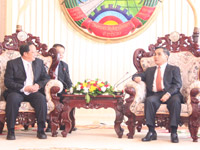Govt promotes renewable energy investment
Govt promotes renewable energy investment
The Lao government is promoting investment in renewable energy development projects and the country expects that renewable energy will comprise around 30 percent of total energy use nationwide by 2025.
“At present there is already a comprehensive renewable energy policy and strategy in Laos and we welcome investment in the renewable energy sector,” Mr Hatsady Sysoulath, the Promotion Director General of the Ministry of Energy and Mines' Institute of Renewable Energy said yesterday.
Mr Hatsady said the comprehensive renewable energy policy and strategy in Laos has been in place since October of last year.
In the past, there was no comprehensive policy and a lack of oversight led to gaps in the management, promotion and development of renewable energy projects. There were some private sector investments in fuel crop plantations but these faced significant obstacles due to the lack of appropriate management mechanisms, according to a report titled “Renewable Energy Development Strategy in the Lao PDR,” published in October 2011 by the Ministry of Energy and Mines, with support from the government of Finland.
Currently, several public organisations and stakeholders have been involved in the development of renewable energy. The ministry has been actively involved in various renewable energy activities, particularly in the development of solar energy, micro hydropower, bio-energy and bio-fuels. The Ministry of Agriculture and Forestry has been conducting a pilot project with small biogas processors, using fuel crops such as jatropha.
The Ministry of Science and Technology has carried out various research projects on renewable energy utilisation in Laos.
Other organisations and institutions, such as universities, research institutes and non-profit organisations have also been involved in renewable energy research and development, the report noted. They named the National University of Laos and the associations of Organic Production Promotion, Agriculture and Handicraft Promotion and Plantation Promotion as some of the organisations involved.
Companies investing in the area include Lao State Fuel, Kolao, Sunlabob Renewable Energy, Luang Prabang Teak Tree Import-Export, Bio-diesel, Lao Agro Tech and Electricite du Laos (EDL).
There are also a number of biofuel projects underway. Lao Agro Tech has commenced a palm oil project, while a jatropha project is being financed by Korea. Both projects are currently planting fuel crops in several provinces of Laos.
The MEM is cooperating with Lao Agro-Tech, which plans to grow oil palms as a source of renewable energy, and has a similar arrangement with Kolao. Biodiesel (BD5) is now being sold in Laos as well. BD5 refers to fuel that is 95 percent diesel and 5 percent bio-fuel.
The Lao Indochina Group Public Company Tapioca Factory will experiment with tapioca production, using biogas to fuel the processing plant in Vientiane. The biogas will replace the use of coal. A Thai company has invested in the biogas plant to resolve the problem of foul odours emanating from the wastewater treatment reservoirs at the factory. The company also plans to use biogas for electricity generation in the future.
A sugar producer in Savannakhet province, Mitr Lao Sugar Co Ltd, started supplying energy to the EDL power grid at the end of last year, using waste sugarcane as a fuel to generate energy.
EDL also expects to sign a memorandum of understanding regarding electricity tariffs with a major Vietnamese sugar and energy investor in Attapeu province this month. The plant will utilise the waste sugarcane as a fuel source.
Impact Electrons Siam Co Ltd, a global electricity generator, hopes to develop a wind power project in Laos within the next five years, with the project now under study.
vientiane times















